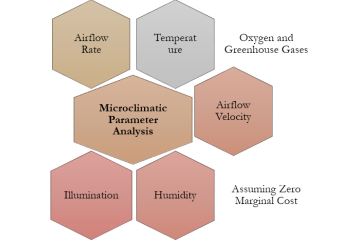Optimizing Livestock Microclimates: BES Models, Challenges, and Sustainable Solutions
Keywords:
Microclimate Conditions, Livestock Buildings, Airflow, Illumination, Gas ContentAbstract
Efficient control of microclimate conditions in livestock buildings is crucial for sustainable livestock production. This paper explores the optimization of energy efficiency through measures such as minimizing energy consumption, adopting eco-friendly technologies, incorporating renewable energy sources, and analyzing economic parameters. Livestock production's impact on global food security is highlighted, emphasizing the importance of effective temperature control in optimizing production. The study delves into the energy consumption patterns in livestock buildings, particularly about heating and ventilation. The role of microclimatic parameters, categorized as physical, chemical, and biological, is crucial in ensuring favorable health conditions for animals. The study identifies a research gap in the existing literature regarding Building Energy Simulation (BES) models for cow housing, leading to the establishment of this study's goals and methodologies. The methodology involves defining the project scope, creating a logical framework, and conducting a comprehensive literature review. The evaluation of BES models for livestock housing is systematically carried out, covering various aspects such as model applications, validation techniques, and constraints. Findings include insights into the specific types of livestock housing considered, key journals publishing relevant works, and a chronological analysis of research output. The study identifies challenges and limitations surrounding BES models in livestock housing, emphasizing the need for standardized validation procedures for reliable and applicable simulation models. Microclimatic parameter analysis provides a detailed examination of sources influencing temperature, humidity, airflow, illumination, and gas content in livestock buildings. Building Performance Simulation (BPS) tools are discussed, highlighting their role in evaluating and analyzing buildings during design and retrofit phases. The study concludes with a focus on models for sustainable advancements in the cattle industry, emphasizing the role of BES models in integrating renewable energy sources and addressing environmental challenges. The paper provides a comprehensive overview of BES models for livestock housing, serving as a valuable reference for future research and contributing to the industry's resilience and sustainability.
References
F. A. M. Tuyttens, “The importance of straw for pig and cattle welfare: A review,” Appl. Anim. Behav. Sci., vol. 92, no. 3, pp. 261–282, Aug. 2005, doi: 10.1016/J.APPLANIM.2005.05.007.
M. G. Lawrence, “The relationship between relative humidity and the dewpoint temperature in moist air: A simple conversion and applications,” Bull. Am. Meteorol. Soc., vol. 86, no. 2, pp. 225–233, Feb. 2005, doi: 10.1175/BAMS-86-2-225.
T. R. Morris, “Livestock Housing, eds C. M. Wathes & D. R. Charles, xi + 428 pp. Wallingford: CAB International (1994). £55.00 or $92.50 (hardback). ISBN 0 85198 774 5.,” J. Agric. Sci., vol. 125, no. 1, pp. 170–170, Aug. 1995, doi: 10.1017/S0021859600074700.
P. J. Hansen, “Exploitation of genetic and physiological determinants of embryonic resistance to elevated temperature to improve embryonic survival in dairy cattle during heat stress,” Theriogenology, vol. 68, no. SUPPL. 1, Sep. 2007, doi: 10.1016/J.THERIOGENOLOGY.2007.04.008.
X. Bai, Z. Wang, L. Sheng, and Z. Wang, “Reliable Data Fusion of Hierarchical Wireless Sensor Networks With Asynchronous Measurement for Greenhouse Monitoring,” IEEE Trans. Control Syst. Technol., vol. 27, no. 3, pp. 1036–1046, May 2019, doi: 10.1109/TCST.2018.2797920.
K. A. Joudi and A. A. Farhan, “A dynamic model and an experimental study for the internal air and soil temperatures in an innovative greenhouse,” Energy Convers. Manag., vol. 91, pp. 76–82, 2015, doi: 10.1016/J.ENCONMAN.2014.11.052.
“Agriculture | Free Full-Text | Technology of Microclimate Regulation in Organic and Energy-Sustainable Livestock Production.” Accessed: Feb. 17, 2024. [Online]. Available: https://www.mdpi.com/2077-0472/12/10/1563
Z. Havelka et al., “Technology of Microclimate Regulation in Organic and Energy-Sustainable Livestock Production,” Agric. 2022, Vol. 12, Page 1563, vol. 12, no. 10, p. 1563, Sep. 2022, doi: 10.3390/AGRICULTURE12101563.
A. Costantino, E. Fabrizio, A. Biglia, P. Cornale, and L. Battaglini, “Energy Use for Climate Control of Animal Houses: The State of the Art in Europe,” Energy Procedia, vol. 101, pp. 184–191, Nov. 2016, doi: 10.1016/J.EGYPRO.2016.11.024.
P. M. Oliveira, E. J. Solteiro Pires, J. Boaventura-Cunha, and T. M. Pinho, “Review of nature and biologically inspired metaheuristics for greenhouse environment control,” Trans. Inst. Meas. Control, vol. 42, no. 12, pp. 2338–2358, Aug. 2020, doi: 10.1177/0142331220909010.
A. Hasni, R. Taibi, B. Draoui, and T. Boulard, “Optimization of greenhouse climate model parameters using particle swarm optimization and genetic algorithms,” Energy Procedia, vol. 6, pp. 371–380, 2011, doi: 10.1016/J.EGYPRO.2011.05.043.
“View of Livestock Protection and Management Starategies.” Accessed: Feb. 22, 2024. [Online]. Available: https://journal.50sea.com/index.php/IJASD/article/view/458/920
I. Andretta, M. Kipper, G. D. Schirmann, C. S. Franceschina, and A. M. L. Ribeiro, “Modeling the performance of broilers under heat stress,” Poult. Sci., vol. 100, no. 9, Sep. 2021, doi: 10.1016/J.PSJ.2021.101338.
M. Gauly et al., “Future consequences and challenges for dairy cow production systems arising from climate change in Central Europe - A review,” Animal, vol. 7, no. 5, pp. 843–859, May 2013, doi: 10.1017/S1751731112002352.
H. Yang, Q. F. Liu, and H. Q. Yang, “Deterministic and stochastic modelling of greenhouse microclimate,” Syst. Sci. Control Eng., vol. 7, no. 3, pp. 65–72, Dec. 2019, doi: 10.1080/21642583.2019.1661310.
Y. Su and L. Xu, “Towards discrete time model for greenhouse climate control,” Eng. Agric. Environ. Food, vol. 10, no. 2, pp. 157–170, Apr. 2017, doi: 10.1016/J.EAEF.2017.01.001.
T. M. Hill, H. G. Bateman, J. M. Aldrich, and R. L. Schlotterbeck, “Comparisons of housing, bedding, and cooling options for dairy calves,” J. Dairy Sci., vol. 94, no. 4, pp. 2138–2146, Apr. 2011, doi: 10.3168/JDS.2010-3841.
A. Pérez-González, O. Begovich-Mendoza, and J. Ruiz-León, “Modeling of a greenhouse prototype using PSO and differential evolution algorithms based on a real-time LabViewTM application,” Appl. Soft Comput. J., vol. 62, pp. 86–100, Jan. 2018, doi: 10.1016/J.ASOC.2017.10.023.
M. Taki, Y. Ajabshirchi, S. F. Ranjbar, A. Rohani, and M. Matloobi, “Heat transfer and MLP neural network models to predict inside environment variables and energy lost in a semi-solar greenhouse,” Energy Build., vol. 110, pp. 314–329, Jan. 2016, doi: 10.1016/J.ENBUILD.2015.11.010.
S. K. Saraswat and A. K. Digalwar, “Empirical investigation and validation of sustainability indicators for the assessment of energy sources in India,” Renew. Sustain. Energy Rev., vol. 145, Jul. 2021, doi: 10.1016/J.RSER.2021.111156.
O. S. Mintaș, D. Mierliță, O. Berchez, A. Stanciu, A. Osiceanu, and A. G. Osiceanu, “Analysis of the Sustainability of Livestock Farms in the Area of the Southwest of Bihor County to Climate Change,” Sustain. 2022, Vol. 14, Page 8841, vol. 14, no. 14, p. 8841, Jul. 2022, doi: 10.3390/SU14148841.
B. Paris et al., “Energy Use in the EU Livestock Sector: A Review Recommending Energy Efficiency Measures and Renewable Energy Sources Adoption,” Appl. Sci., vol. 12, no. 4, Feb. 2022, doi: 10.3390/APP12042142.
K. Brügemann, E. Gernand, U. König Von Borstel, and S. König, “Defining and evaluating heat stress thresholds in different dairy cow production systems,” Arch. Anim. Breed., vol. 55, no. 1, pp. 13–24, Oct. 2012, doi: 10.5194/AAB-55-13-2012.
T. Głuski, M. Patro, A. Marczuk, W. Misztal, K. Szwedziak, and Z. Grzywacz, “24-Hour Microclimate Conditions in Livestock Building,” Agric. Eng., vol. 23, no. 3, pp. 41–49, Sep. 2019, doi: 10.1515/AGRICENG-2019-0024.
T. L. Mader, M. S. Davis, and T. Brown-Brandl, “Environmental factors influencing heat stress in feedlot cattle,” J. Anim. Sci., vol. 84, no. 3, pp. 712–719, 2006, doi: 10.2527/2006.843712X.
D. Tikhomirov, A. N. Vasilyev, D. Budnikov, and A. A. Vasilyev, “Energy-saving automated system for microclimate in agricultural premises with utilization of ventilation air,” Wirel. Networks, vol. 26, no. 7, pp. 4921–4928, Oct. 2020, doi: 10.1007/S11276-019-01946-3.
N. Kiktev et al., “Automated microclimate regulation in agricultural facilities using the air curtain system,” Sensors, vol. 21, no. 24, Dec. 2021, doi: 10.3390/S21248182.
D. E. Buffington, A. Collazo-Arocho, G. H. Canton, D. Pitt, W. W. Thatcher, and R. J. Collier, “Black Globe-Humidity Index (BGHI) as Comfort Equation for Dairy Cows,” Trans. ASAE, vol. 24, no. 3, pp. 0711–0714, 1981, doi: 10.13031/2013.34325.
S. M. McGuirk, “Disease Management of Dairy Calves and Heifers,” Vet. Clin. North Am. - Food Anim. Pract., vol. 24, no. 1, pp. 139–153, Mar. 2008, doi: 10.1016/J.CVFA.2007.10.003.
B. A. Kimball, “Simulation of the energy balance of a greenhouse,” Agric. Meteorol., vol. 11, no. C, pp. 243–260, 1973, doi: 10.1016/0002-1571(73)90067-8.
L. N. Edwards-Callaway et al., “Impacts of shade on cattle well-being in the beef supply chain,” J. Anim. Sci., vol. 99, no. 2, Feb. 2021, doi: 10.1093/JAS/SKAA375.
L. Belhaj Salah and F. Fourati, “A greenhouse modeling and control using deep neural networks,” Appl. Artif. Intell., vol. 35, no. 15, pp. 1905–1929, 2021, doi: 10.1080/08839514.2021.1995232.
G. Schauberger, M. Piringer, and E. Petz, “Steady-state balance model to calculate the indoor climate of livestock buildings, demonstrated for finishing pigs,” Int. J. Biometeorol., vol. 43, no. 4, pp. 154–162, 2000, doi: 10.1007/S004840050002.
G. Messina et al., “Italian medical students quality of life: Years 2005-2015,” Ann. di Ig. Med. Prev. e di Comunita, vol. 28, no. 4, pp. 245–251, 2016, doi: 10.7416/AI.2016.2103.
E. C. Thom, “The Discomfort Index,” Weatherwise, vol. 12, no. 2, pp. 57–61, Apr. 1959, doi: 10.1080/00431672.1959.9926960.
H. C. Lee and C. Ter Chang, “Comparative analysis of MCDM methods for ranking renewable energy sources in Taiwan,” Renew. Sustain. Energy Rev., vol. 92, pp. 883–896, Sep. 2018, doi: 10.1016/J.RSER.2018.05.007.
W. Romaniuk et al., “Biomass energy technologies from innovative dairy farming systems,” Processes, vol. 9, no. 2, pp. 1–19, Feb. 2021, doi: 10.3390/PR9020335.
U. Bernabucci, S. Biffani, L. Buggiotti, A. Vitali, N. Lacetera, and A. Nardone, “The effects of heat stress in Italian Holstein dairy cattle,” J. Dairy Sci., vol. 97, no. 1, pp. 471–486, Jan. 2014, doi: 10.3168/JDS.2013-6611.
C. T. Kadzere, M. R. Murphy, N. Silanikove, and E. Maltz, “Heat stress in lactating dairy cows: A review,” Livest. Prod. Sci., vol. 77, no. 1, pp. 59–91, 2002, doi: 10.1016/S0301-6226(01)00330-X.
K. Andonov, P. Daskalov, and K. Martev, “A new approach to controlled natural ventilation of livestock buildings,” Biosyst. Eng., vol. 84, no. 1, pp. 91–100, Jan. 2003, doi: 10.1016/S1537-5110(02)00218-0.
C. A. John, L. S. Tan, J. Tan, P. L. Kiew, A. M. Shariff, and H. N. Abdul Halim, “Selection of renewable energy in rural area via life cycle assessment-analytical hierarchy process (LCA-AHP): A case study of Tatau, Sarawak,” Sustain., vol. 13, no. 21, Nov. 2021, doi: 10.3390/SU132111880.




